Drying Sunflower Sunflower Heads and Petals
Enjoy sunflowers? Grow them in your garden or add grocery store sunflowers to crafts but don’t know the best techniques? I’m here to help you figure out what works best for you. I will share how to have our feathered friends have a tasty treat during winter. So let’s dive into the best time for drying sunflowers, sunflower heads, and petals.
Table of Contents
- 1 Drying Sunflower Sunflower Heads and Petals
- 2 Drying Sunflower Sunflower Heads and Petals: Nature’s Sunshine
- 3 Join The Journey
- 4 Questions
- 5 Cutting Sunflowers
- 6 Sunflowers Birds And Local Wildlife
- 7 Drying Sunflower Sunflower Heads and Petals
- 8 Harvesting Timing: Capturing Sunflowers At Their Peak
- 9 Essential Tools and Materials for Drying Success
- 10 Step-by-Step Drying Process:
- 11 Drying Sunflowers
- 12 Air Drying
- 13 Drying The Flower Petals
- 14 Oven Drying: Efficient Transformation
- 15 Preparing Petals and Heads for Gel
- 16 Placing Sunflower Heads: A Delicate Touch
- 17 Drying the Petals
- 18 Microwave Drying Sunflowers: Rapid Transformation with Caution
- 19 Creative Uses for Dried Sunflowers:
- 20 Blending Dry Petals And Herbs
- 21 Aroma and Atmosphere: Crafting Natural Potpourri
- 22 Why Enjoy Drying Sunflowers And The Sunflower Head?
- 23 End of Season Sunflowers
- 24 Drying Sunflowers Sunflolwer Heads And Petals
- 25
- 26 DRYING SUNFLOWERS SUNFLOWER HEADS AND PETALS
- 27
Drying Sunflower Sunflower Heads and Petals
Top Drying Techniques and Creative Uses for Your Harvest
I will cover the methods and techniques that allow you to transform these into treasures. Whether you’re a gardening enthusiast seeking to make the most of your harvest or craft decorations. for the next season. I will share the best way to dry sunflowers in all their glory which usually bloom in late summer into early fall. I will speak about why dry sunflower seeds are beneficial and a tasty treat for local wildlife and about adding them to a bird feeder for our feathered friends in the winter when food is scarce.
Jump to DIY CardDrying Sunflower Sunflower Heads and Petals: Nature’s Sunshine
Sunflowers also known as helianthus annuus, with their yellow petals and large presence, capture the essence of the sunny days of late summer and early fall. These beautiful flowers bring a touch of nature to any setting. Their vibrant colors grace gardens and landscapes but have the potential to add beauty to our homes after they’ve been cut from their stems.
Preserving the sunflower, the head, and petals through drying offers different ways to extend their beauty and bring a touch of nature indoors.
I will share the art of drying sunflowers, the seed head, and yellow petals with drying methods and techniques. Harvesting these at the right time allows us to transform these beautiful flowers into treasures from late summer and fall.
Whether you are a gardening enthusiast seeking to make the most of your sunflowers or are eager to create crafts for decorations with a bit of nature, this guide will share the knowledge needed to dry sunflower heads, and their flower petals without winding up with moldy flower head. So, let’s learn how to capture the beauty at the end of the season with dry sunflowers and enjoy their natural charm.
Join The Journey
I will share the simple process for drying sunflowers the different ways to achieve the best results and information about the optimal conditions for dry sunflower heads and their petals until we can enjoy them next season when they bloom.
Discover a variety of uses that breathe new life into these beautiful cut flowers. Whether you’re a beginner or a seasoned DIYer, this will be rewarding and inspiring to enjoy at the end of the season.
Questions
What’s The Best Way To Dry These Flowers?
There are several methods for drying these beautiful flowers. The traditional air-drying method is the easiest way to dry our own sunflowers for crafts and home decorating. A great way to achieve dried heads is to cut six inches of stem and bundle them in threes with twine or a rubber band. Hang sunflowers upside down in a dry dark place away from direct sunlight, low humidity levels, and a well-ventilated area. If these are from your garden, beware there will be many bugs in the flowers. I know this well from drying hydrangeas every season. So, I advise shaking these out well before bringing them indoors. My sunflowers are from the store so I don’t need to worry.
How Long Is The Drying Time?
To dry sunflowers, the drying time generally takes 2-3 weeks and depends on the size of the sunflower heads. The length of the drying process for sunflowers will also vary due to humidity levels and if the sunflowers are hanging in a dark and dry place away from direct sunlight. So with a little patience, you can enjoy sunflowers in the home throughout the winter months.
Cutting Sunflowers
How do you cut a Sunflower?
My research says the best time to cut sunflowers is to cut them in the morning when the dew has evaporated on a dry sunny day. The sunflowers should have vibrant colors and no brown color on their petals. Bring paper towels with you because their sap is VERY sticky! It reminds me of collecting and cleaning pine cones and removing the pine needles.
Be sure you have the essential tools, such as gardening shears or scissors. When cutting leave six inches of stem from the head of the flower, and remove leaves and any plant matter.
After the flowers have dried, the best choice is to spray the dry flowers with unscented hairspray. This is the best way to keep their color.
Sunflowers Birds And Local Wildlife
Feathered Friends And Furry Neighbors: Who Loves Dry Sunflower Seeds?
Dry sunflower seeds are a great food source for wildlife and they can play a significant role in supporting ecosystems. Here’s how dry sunflower seeds can benefit local wildlife:
- *Food Source: Dry sunflower seeds are a nutritious snack, tasty treat, and food source for local wildlife. Birds, such as cardinals, finches, and sparrows, are known to feast on the dry seeds. Small animals like squirrels and chipmunks may also enjoy these tasty snacks.
- *Healthy Environment: Offering ripe seeds from sunflowers in your garden or a bird feeder can attract wildlife. This provides food for various species but also creates opportunities for observing and appreciating nature around you.
- *Support for Birds Winter Months: The best time to offer sunflower seeds is during winter months when natural food sources can become scarce. By providing this tasty treat, you can help birds survive harsh winter conditions.
- *Raises Awareness: Watching wildlife interact with sunflower seeds in a bird feeder can be a fun experience. It raises awareness about local bird populations and encourages an appreciation for conservation efforts.
- *Seed Spreading: Birds and small animals will aid in the spreading of sunflower seeds for next year’s garden. When they eat the seeds and later deposit them elsewhere, they contribute to the growth of new sunflower plants, for the growing season.
It’s important to note that while providing dry sunflower seeds for wildlife is generally beneficial, it’s important to do this responsibly. Be sure that your feeding practices don’t attract unwanted pests. Regularly clean the bird feeder to maintain a healthy and safe environment for local wildlife.
Drying Sunflower Sunflower Heads and Petals
Discover Techniques to Dry Sunflowers From Air Dring to Oven and Microwave
There are different ways to dry varieties of sunflowers, the traditional air-drying technique is an easy approach, allowing sunflower heads to retain their natural shape while hanging flower heads upside down or lying flat in a single layer.
If time is of the essence, consider using your oven at a low temperature or a microwave for rapid drying.
Silica is a drying agent that draws out moisture from the petals and dried sunflower heads. Choosing the appropriate drying method that works with your time constraints, ensures optimal results for later use whether in your home decor or crafting.
Harvesting Timing: Capturing Sunflowers At Their Peak
The first step, before drying the preparation is important for this DIY method. The right time to choose sunflowers is at the peak of their growing season with vibrant color.
If you are fortunate to have sunflowers growing in your garden or have a special spot to harvest your own flowers, my research has mentioned that conditions and timing are crucial.
I read the right time to cut sunflowers is on a dry, sunny day, in the morning when the dew has evaporated.
Essential Tools and Materials for Drying Success
Be sure you have the essential tools, such as gardening shears or scissors for cutting six inches of stem. Also, bring paper towels or rags as I said they are sticky. Don’t forget a rubber band or twine for bundling your fresh cut flowers and make sure the heads and petals don’t touch one when bundling. This can cause a moldy flower head, no one wants that to happen.
Sunflowers for arrangements the stems can be left long to accommodate pitchers and baskets. Sunflowers are bright and cheerful to add to our homes for fall, with pine cones, nuts, acorns for centerpieces, and more. They are perfect to get us through the long winter months.
The rustic nature of the dry sunflower and dry sunflower seed heads mixes beautifully with dried lavender. The color combination creates the perfect blend of natural elements. If you have been a follower of Cloches & Lavender, you know how I embrace nature’s gifts, especially during fall and Christmas.
Step-by-Step Drying Process:
Supplies List:
- *Twine, jute, rubber band
- *Hangers with clips, and a flowering hanging rack, this is a great option.
- *Peg Rack (hang in a dry place and dark place away from direct sunlight)
- *A pair of scissors
- *Paper towels
Once you have your DIY method in mind, follow these step-by-step instructions to achieve the best outcome.
Drying Sunflowers
Air Drying Technique: Graceful Preservation in Progress
In my opinion, the best choice and easiest way to dry sunflower heads is the air-drying technique. It takes a little patience but it is worth it. I will share various factors that work best with this drying technique. Following these steps is the best way to dry these cut flowers and avoid a moldy flower head.
I have used this process many times over the years, to dry different flowers such as peonies, roses, and my favorite, hydrangeas. So when it came to dried sunflower heads, this is the process I chose. I will share the easiest way to use other drying methods.
Last year, our grocery store didn’t have sunflowers with a large head, a bit disappointing, usually the sunflowers’ heads are much larger. So, the size of the sunflower heads was smaller than normal.
I look forward to drying sunflowers and the seed head every year and one of the reasons I love decorating with nature. Visit my fall and Christmas home tours you will see how I embrace nature. Nature offers the beast gifts to add to our homes and it’s FREE!

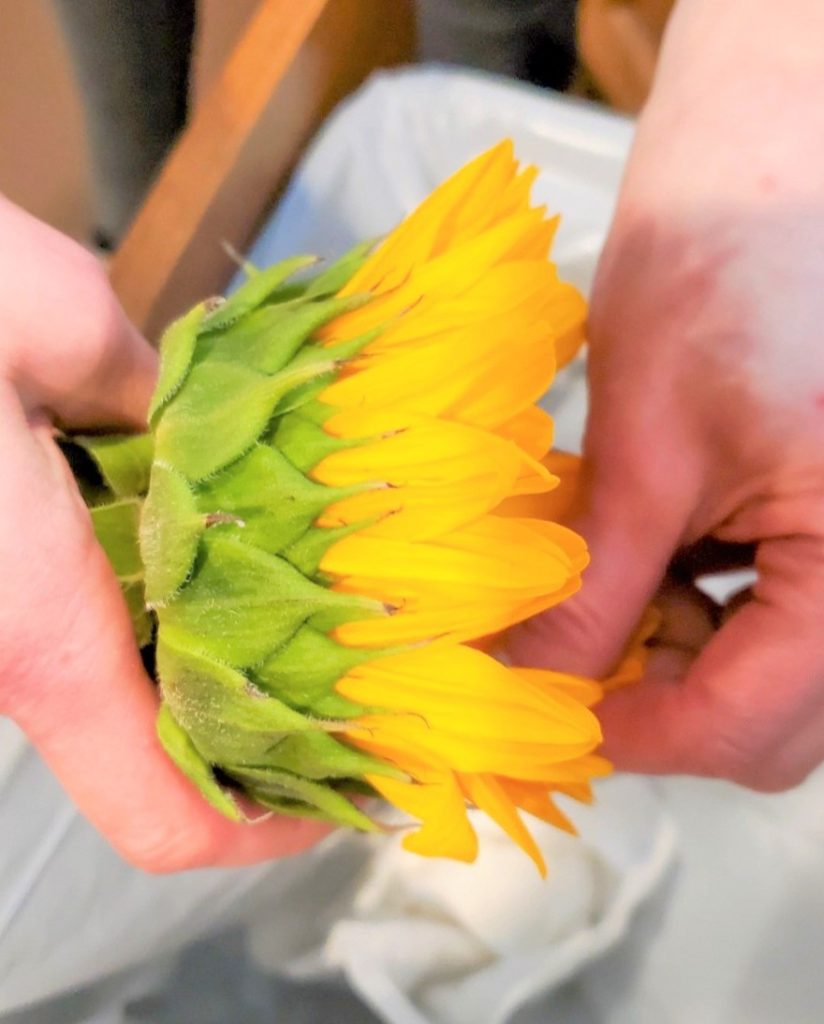
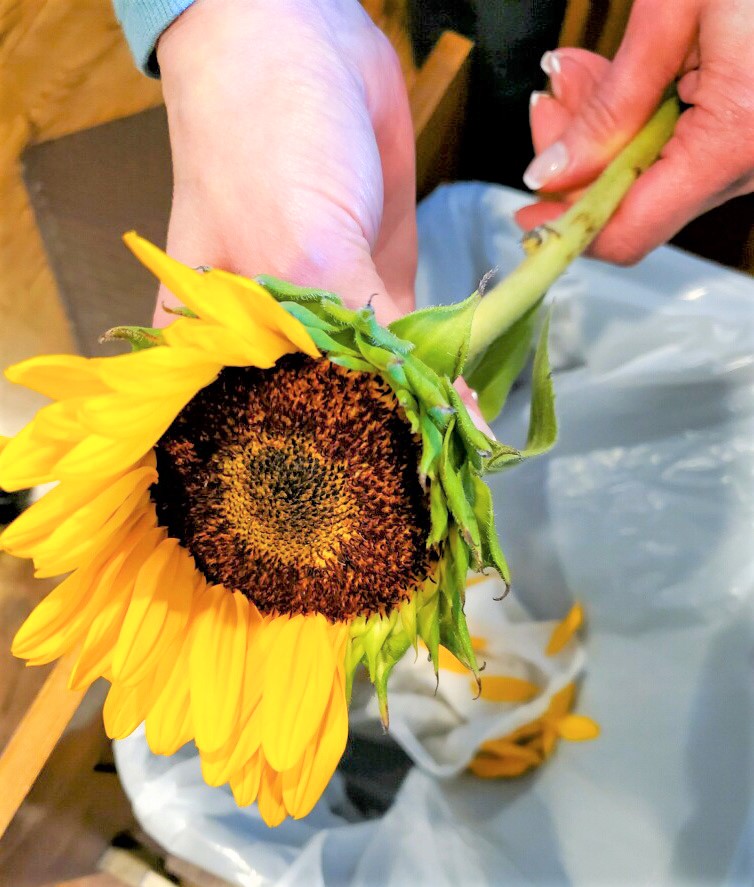
Air Drying
The first step before drying flowers is to remove excess leaves and plant matter. Bundle the sunflowers with a rubber band or twine in groups of three. Allow enough space so the sunflowers’ petals do not touch one another. You will wind up with a moldy flower head. This DIY method has been a great way to dry my own sunflowers over the years.
Hang the sunflowers upside down in a dry place and a dark place away from direct sunlight is a must. For best results low humidity levels and a well ventilated area are optimal conditions so be sure this is the case.
The drying time for sunflowers will vary from 2-3 weeks, depending on the size of the flower heads. The duration can also vary depending on room temperature and humidity levels.
After the sunflowers are dry to keep their vibrant colors, I spray them lightly with unscented hairspray and it works. Remember dry flowers do break down after a while.
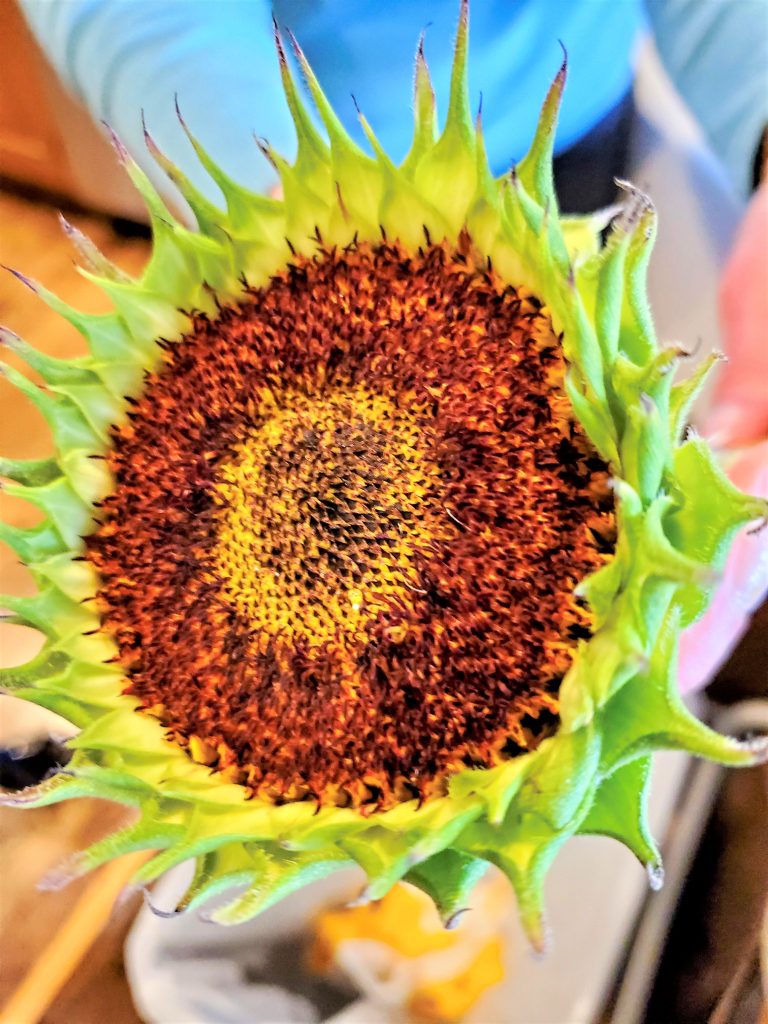
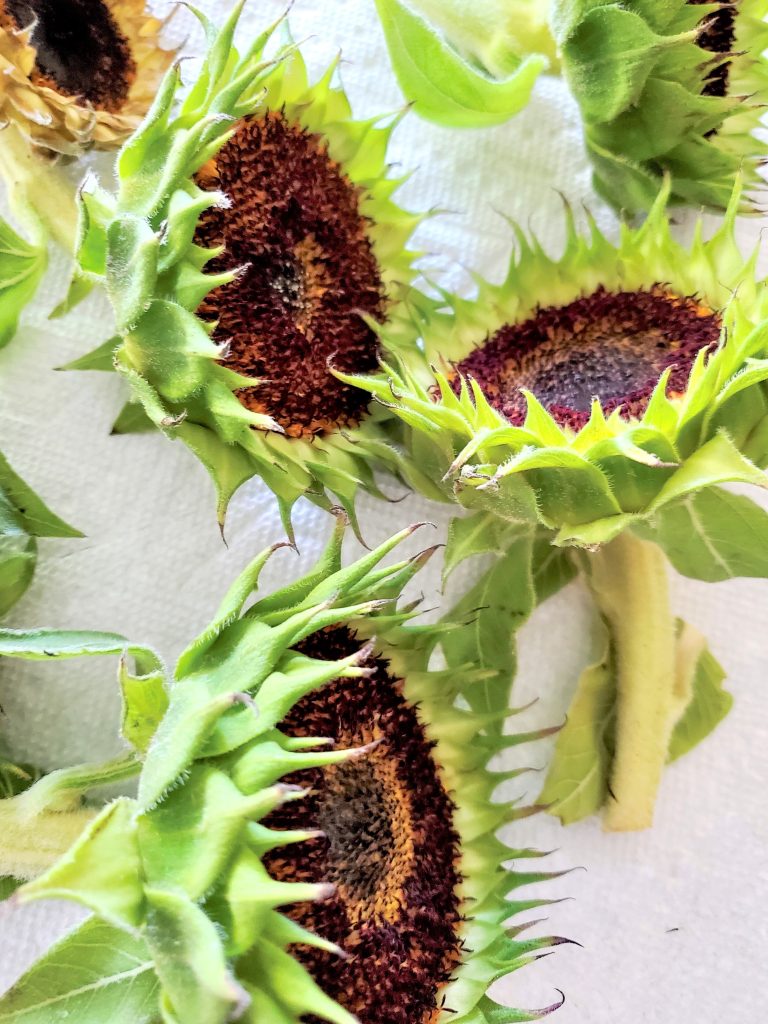
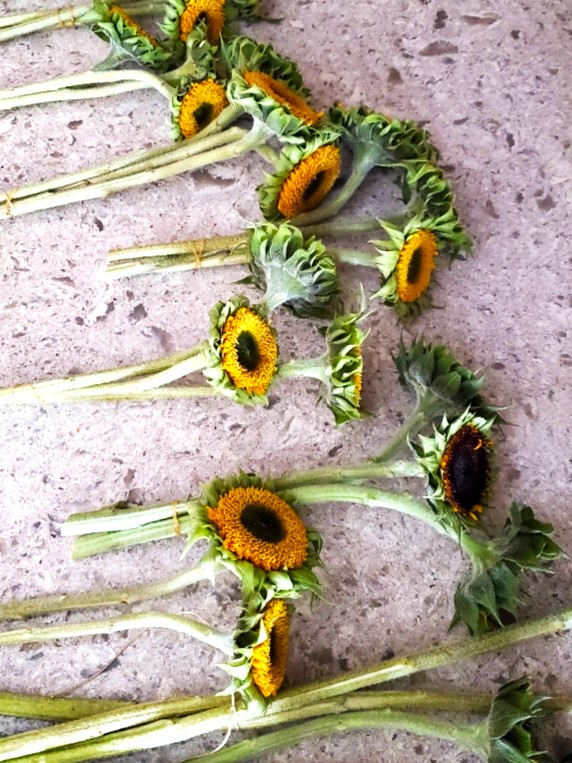
Dry Sunflower Heads
Begin by removing excess leaves, plant matter, and outer ray petals from the head, and cutting six inches of the stem. The next step is bundling the heads with a rubber band or twine in groups of three.
Allow enough space so the sunflower seed heads do not touch one another. This has given me great results when drying my sunflowers every year.
Hanging flower heads upside down in a dry place, a dark place away from direct sunlight with low humidity levels in a well ventilated area are the optimal conditions for this simple process.
The drying time for sunflowers will vary from 2-3 weeks, depending on the size of the sunflower heads.
After the head of the flower dries to keep its bright color, spray lightly with unscented hairspray.
Drying The Flower Petals
Flat Drying Method: Natural Grace Retained
To dry sunflower petals, carefully remove the yellow petals. After removing the outer ray petals, use two sheets of parchment paper or blotting paper and lay them in a single layer. I typically like to press our petals face-side down.
Lay the petals face-side down and let them dry for two weeks.
Next step, I placed a heavy marble pastry board on top to give the petals a flat surface and I let the petals dry for two weeks.
Drying the petals can also be achieved using cardboard, blotting paper, or natural parchment paper. Stack cardboard, then paper, and cardboard on top of the petals. Add them to a heavy book and check them in two weeks. The sunflower petals should have a dry papery touch, if not add them to the book and dry the flower petals longer.
To keep the vibrant colors of the petals, spray lightly with unscented hairspray.
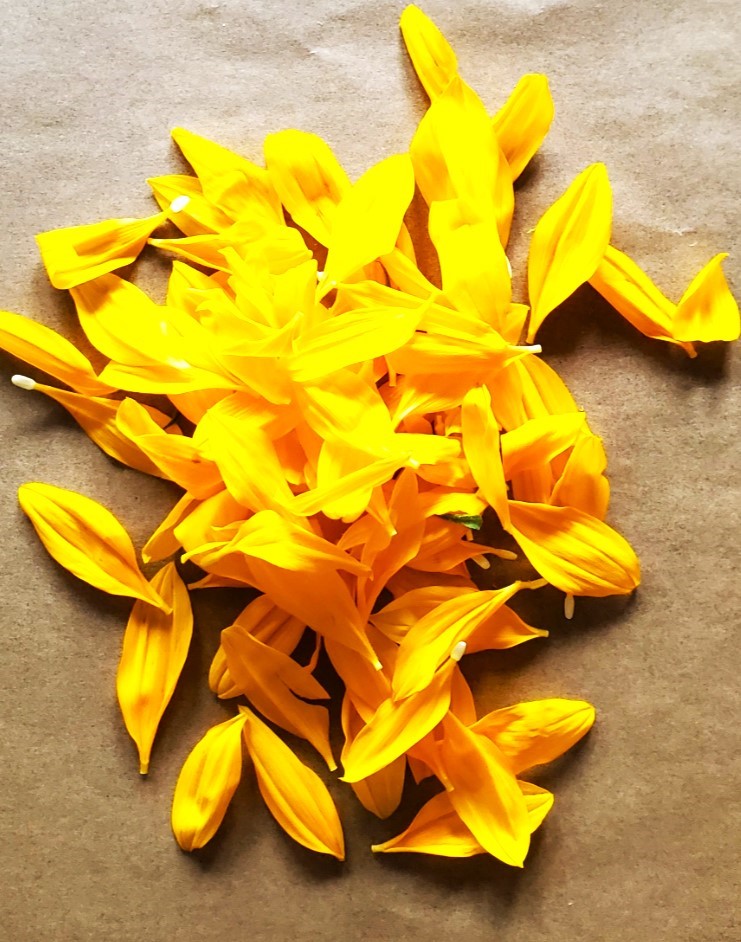
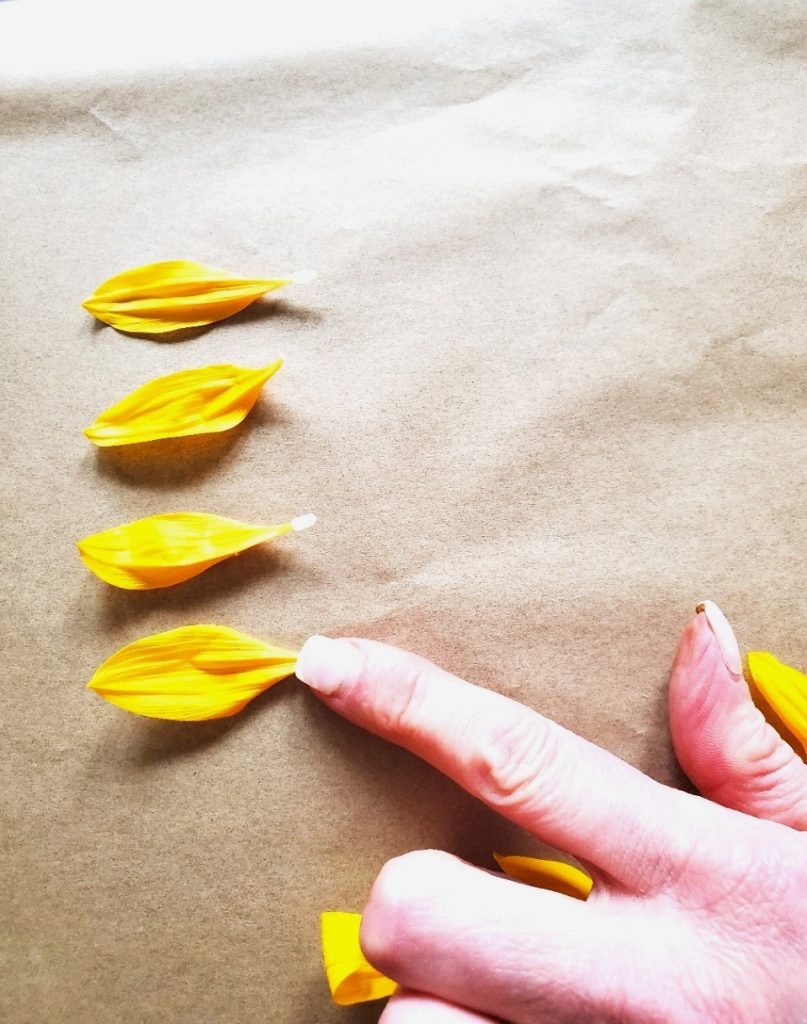
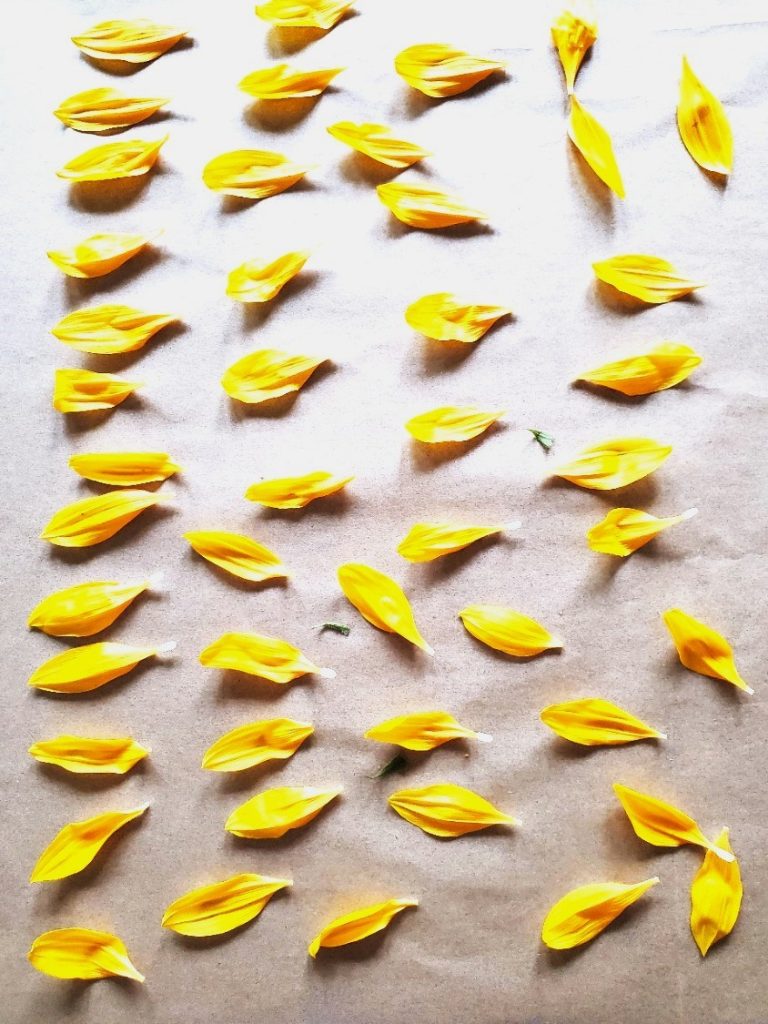
Oven Drying: Efficient Transformation
Trimming and Preparing: Setting the Stage for Drying
Preheat the oven to 200 degrees F.
Begin by removing any plant matter, and leaves and trim the stem with a little stem on the back of the flower head. Lay on paper towels to avoid sticky sap on your hands and counter.
Lay each head of the flower in a single layer on a wire rack on a cookie sheet or baking sheet. Bake 1-2 hours. The information I found says it’s a good idea to check the flowers after one hour. This is to make sure the head of the sunflower isn’t becoming a brown color.
it says it’s a good idea to check the sunflower every 120 minutes during the drying process to achieve the best results.
Preparing Petals and Heads for Gel
Silica Gel Magic Step-by-Step Process: Time and Care Unveiled
Supplies List:
- *Fresh flowers
- *Silica Gel (not silica sand)
- *Airtight plastic container
- *Pruners or scissors
- *Gloves and mask (recommended)
- *Paper Towels
Preparing Petals and Heads for Gel
Placing Sunflower Heads: A Delicate Touch
Silica is non-toxic, however, it’s advised to wear a mask and gloves for extra safety. Silica particles may irritate the throat and your skin so safety is important.
To dry the head of the sunflower in silica gel, cut it leaving two inches of stem, and it should face up in an airtight container. Add the gel over the head until completely covered, and allow the petals and the head to dry for 2-7 days. Store the airtight container in a cool, dry location. If the container is deep enough, you can preserve two layers of the heads at a time.
Drying the Petals
Flat Drying Method: Natural Grace Retained
If you’re using silica gel to dry the flower petals of a sunflower, you want a 1-inch layer of silica on the bottom of your airtight container.
Layer the flower petals in a single layer in your airtight container and sprinkle the silica covering the flower petals completely.
The silica gel drying process should take 2-7 days. Put the airtight container in a cool, dry place. Be sure the moisture is removed from the yellow petals and the seed head, or you may wind up with a moldy flower head.
Microwave Drying Sunflowers: Rapid Transformation with Caution
Intervals and Monitoring: Quick and Controlled Drying
The microwave drying process for sunflower petals and the head of the flower is quick and requires heat many times. It’s advisable to wear gloves and a mask. Silica is non-toxic but can irritate the throat and skin. For safety reasons, it’s best to wear gloves and a mask.
Cut the sunflowers with two inches of stem.
Using a microwave-safe container, add 1 inch of gel. Add the head or petals and cover the flowers, with gel.
Set the microwave on high power for 20-40-second intervals.
By adhering to these detailed steps, you’ll ensure the successful preservation of your sunflowers.
Wearing gloves, carefully remove each head of the sunflower and petals and wipe off any remaining gel.
Spray the dried sunflower heads, sunflowers, or flower petals with unscented hairspray to keep their bright colors.
Creative Uses for Dried Sunflowers:
Home Decor Delights: Sunflowers in Every Nook
Enjoy all the possibilities dried sunflowers, the head, and their petals have to offer. Add these beautiful flowers to your home decor and craft wreaths that add rustic charm with their natural beauty.
- *Couple the dried sunflowers with one of my favorites, dried lavender to create a stunning early fall display.
- *Couple these cut flowers or the head of the flower in table settings, centerpieces, or inside a basket, and surround yourself with nature’s beauty.
- *The dry seed heads will look beautiful in a dough bowl as a centerpiece on the dining table with pine cones, nuts, acorns, and dried artichockes for the fall season. Remove the sunflowers and it’s perfect for Christmas and winter.
- *Add dried artichokes, pinecones, dried orange slices, cinnamon sticks, and star anise on top, and add a beautiful woodsy scent to your fall home decor. Remove the flowers and it works for the holiday season straight through winter.
- *Or tie dried sunflowers in bundles with a beautiful satin ribbon in fall colors and add them to a pitcher on an accent table or to your fireplace mantle. Remove the flowers and add evergreen branches for the holiday season.
- *I found a good idea to give sunflower seeds as gifts at A Country Girl Life.
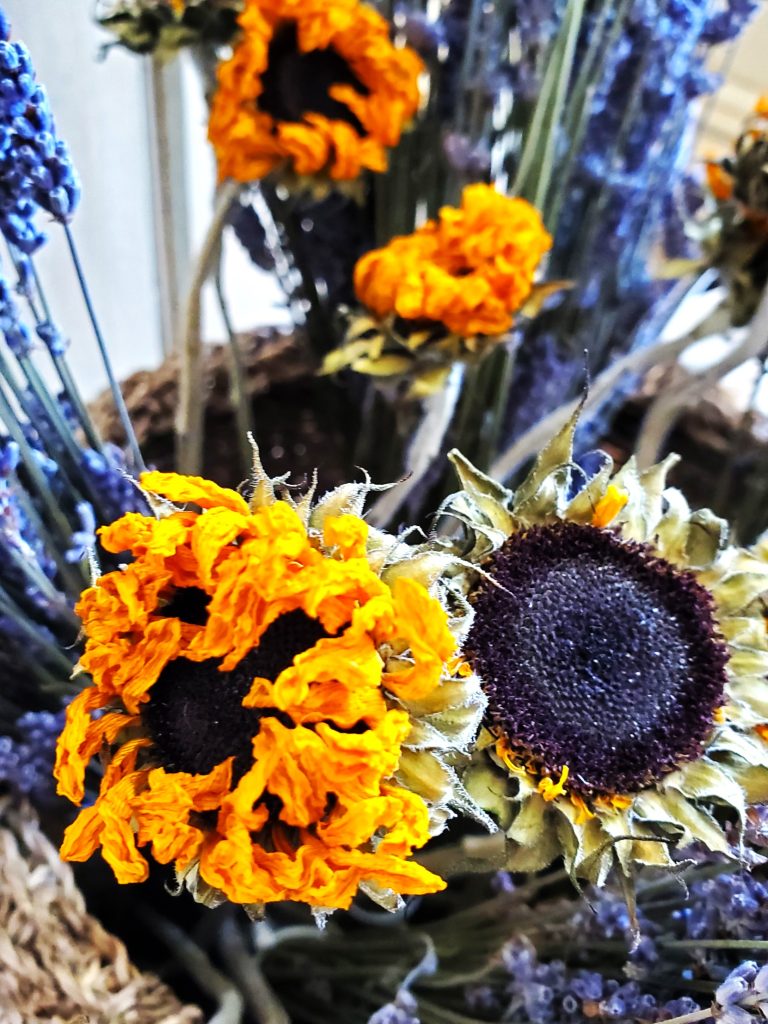
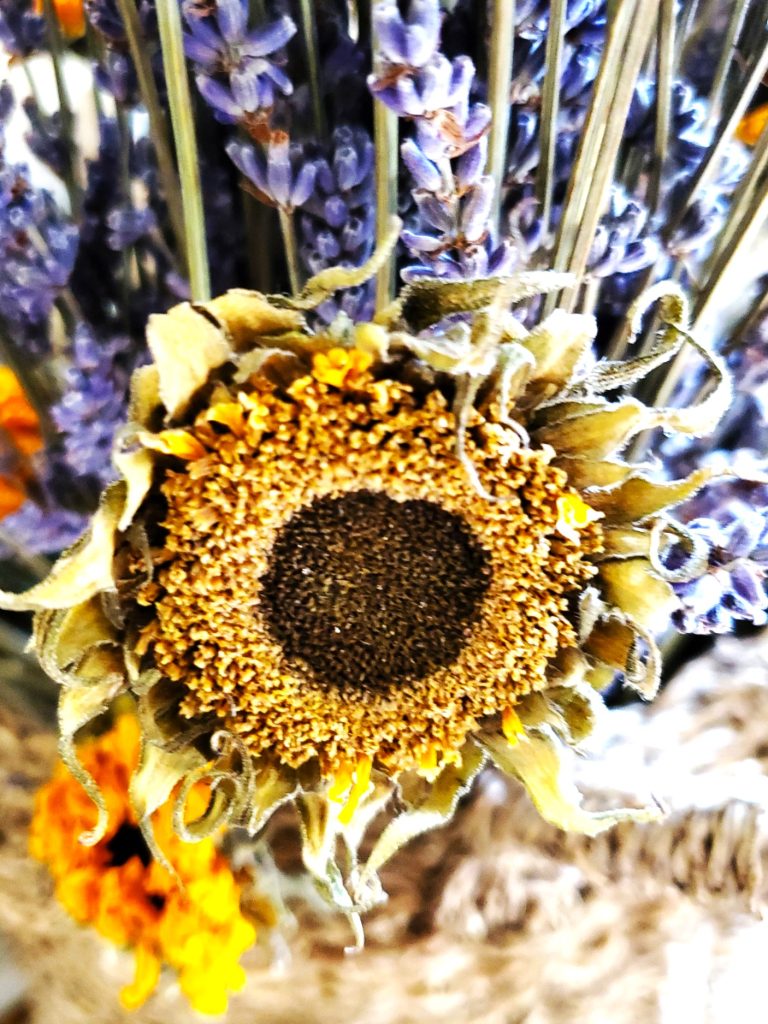
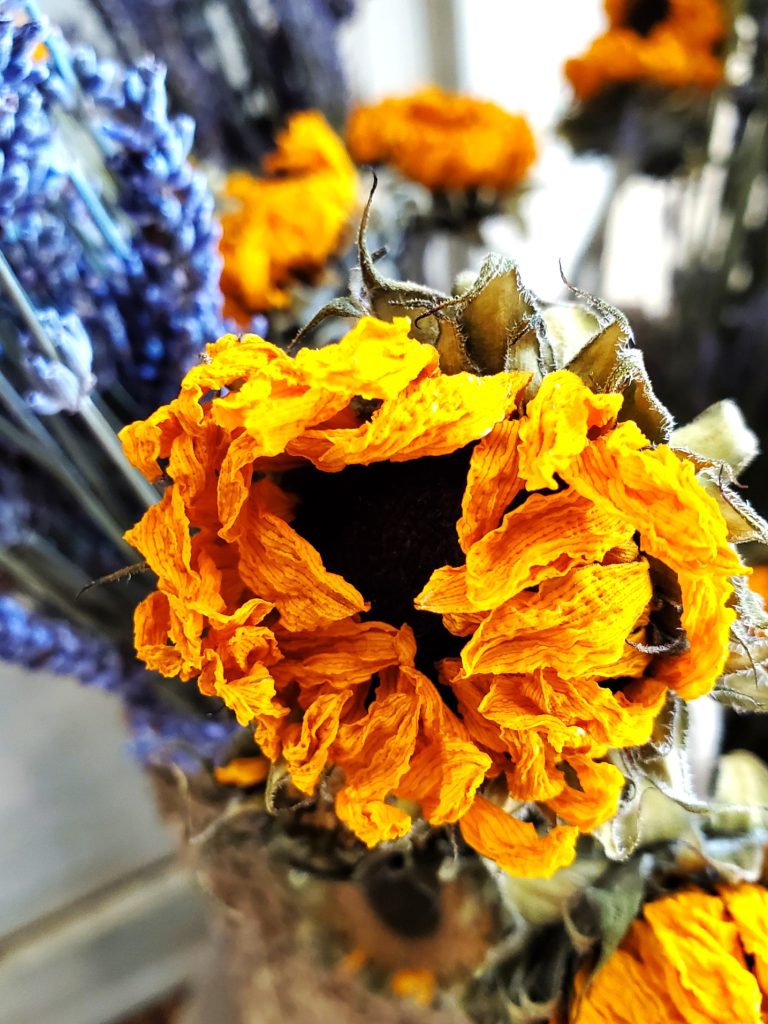


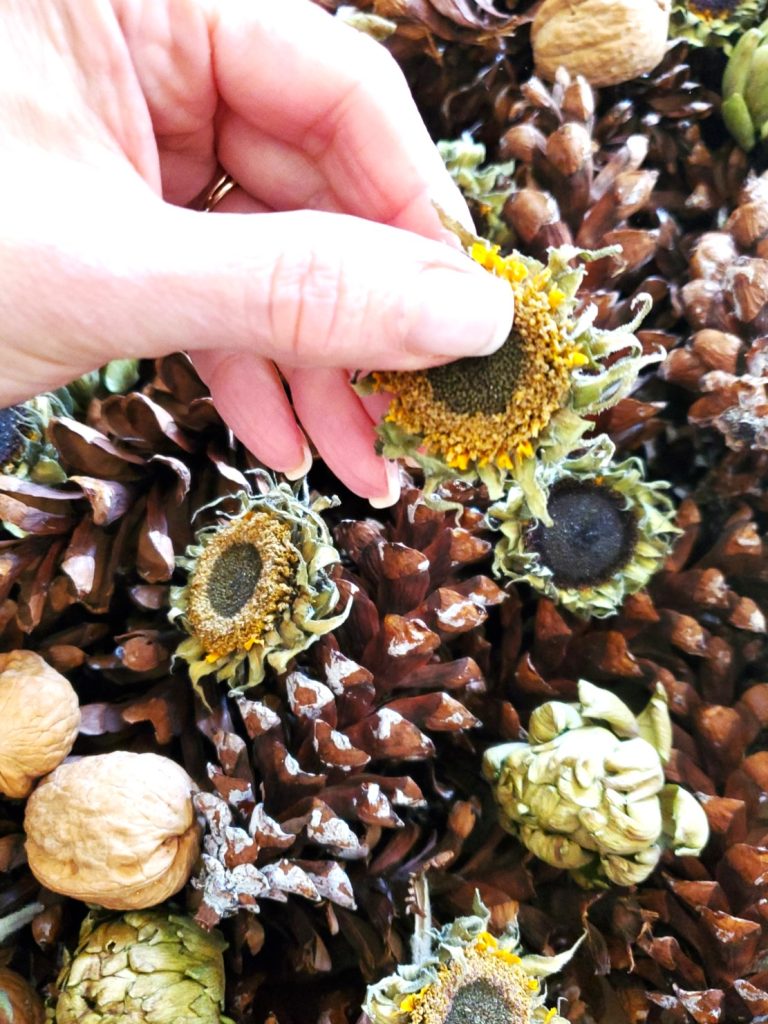
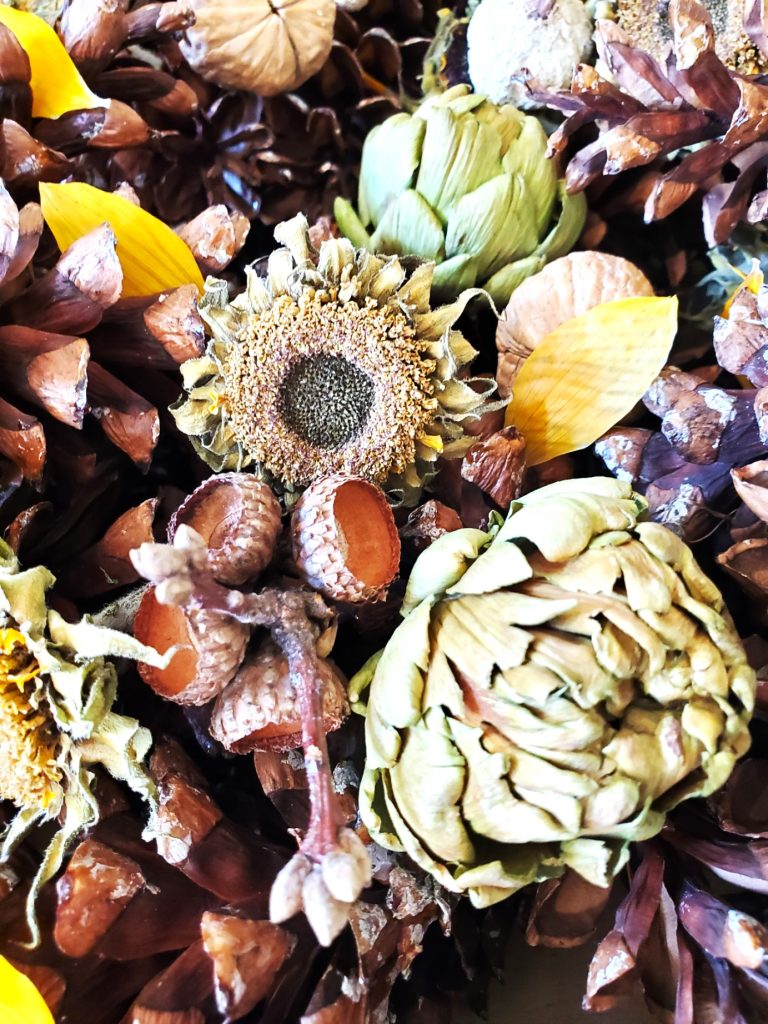
Blending Dry Petals And Herbs
Aroma and Atmosphere: Crafting Natural Potpourri
Make a natural potpourri, blending the dried petals with herbs, pinecones, dried orange slices, and cinnamon sticks in a bowl to welcome guests for a simple fall gathering.
Why Enjoy Drying Sunflowers And The Sunflower Head?
- Discover Timeless Elegance: Unleash your creativity with dried sunflowers, seed heads, and flower petals. Transform nature’s beauty into crafts, decorations, and gifts that stand the test of time. Start your preservation journey today and let the radiance of dried botanicals brighten your world.
- Craft with Nature’s Bounty: Embrace the magic of dried sunflowers, seed heads, and dry petals as you embark on crafting adventures. Whether you’re an experienced DIY enthusiast or just beginning, let these dried treasures inspire you to design pressed art, charming wreaths, and potpourri. Elevate your crafting endeavors with the dried botanicals.
- Preserve Memories, Spread Joy: Experience the joy of preserving the golden moments of sunflowers with dried seed heads and delicate flower petals. Capture the essence of sunny days in your crafts, home decor, and heartfelt gifts. Embrace the art of drying and discover the possibilities that let you share the beauty of nature’s treasures. Discover the best time to start your journey drying flowers now!
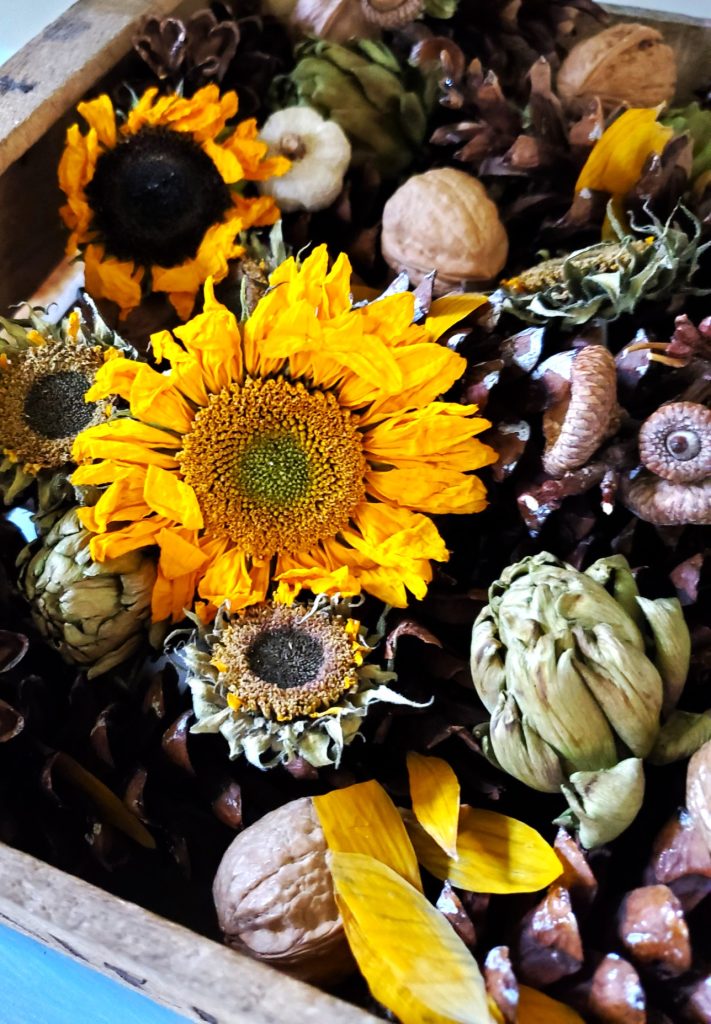
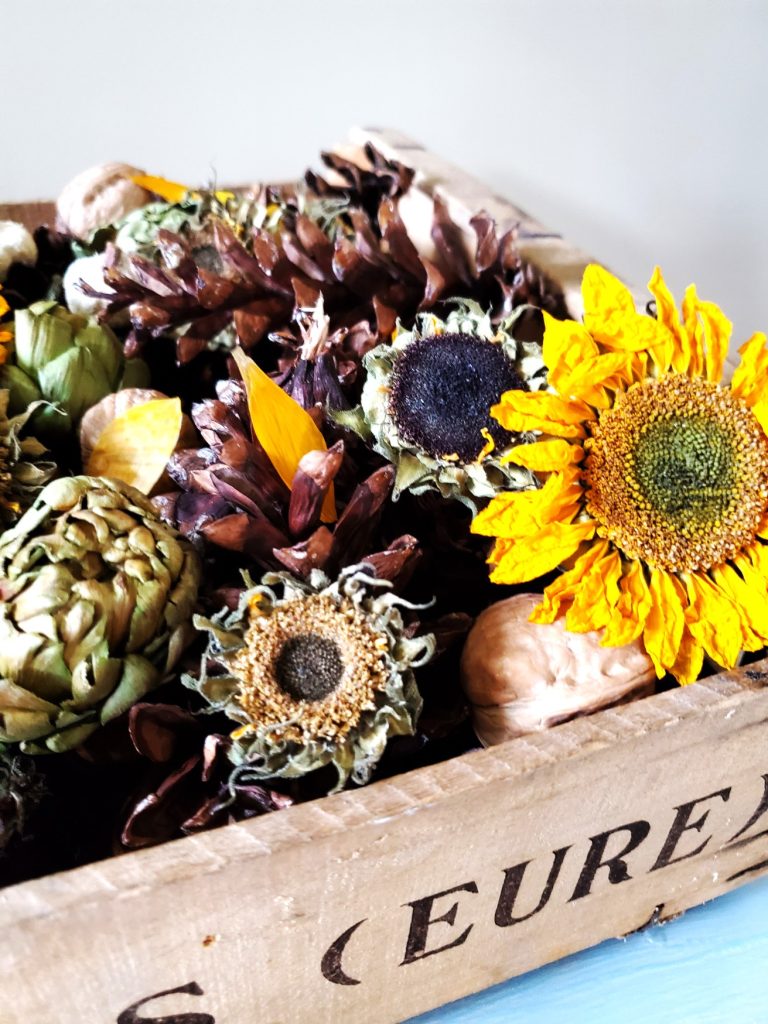
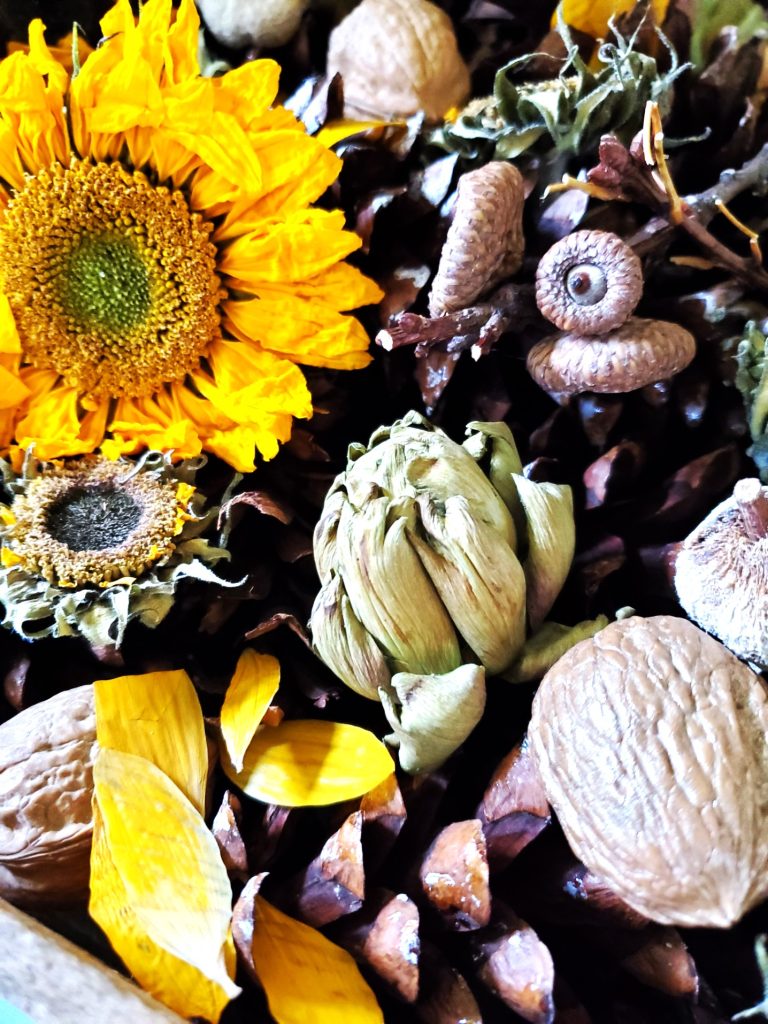
End of Season Sunflowers
Enjoying Varieties of Sunflowers Simple Process Until Next Time
As we wrap up the simple process of drying sunflowers, sunflower heads, and petals enjoy the process until the next growing season. It’s bittersweet when these flowers are at the end of the season. With a little patience preserving varieties of sunflowers in different ways, you’ve transformed this late summer and early fall beauty into nature’s charm for your home.
Share your plans and thoughts on how to dry the sunflower, the seed heads, and the petals. I look forward to hearing how you enjoyed these blooms until their next growing season in your homes. I look forward to sharing other easy projects and crafts with so follow Cloches & Lavender so you never miss any DIYs, crafts, and more.
Share with us your plans and thoughts on drying sunflowers, the seed head, and the petals. We look forward to hearing from our readers.
FOLLOW US ON: FACEBOOK, INSTAGRAM AND PINTEREST.
Drying Sunflowers Sunflolwer Heads And Petals
Equipment
- 1 roll of twine or jute,
- 1 can unscented hairspray
- paper towels
- cookie sheet
- 1 pair of scissors or a garden pruner
- rubber band
- 1 airtight plastic container
Notes
DRYING SUNFLOWERS SUNFLOWER HEADS AND PETALS
Supplies Needed:-
-
-
- *Twine, jute, rubber band
-
- *Hangers with clips, and a flowering hanging rack
-
- *Peg Rack (hang in a dry place and dark place away from direct sunlight)
-
- *A pair of scissors
-
- *Paper towels
-
- *Scissors
-
Drying Sunflowers
The first step before drying flowers is to remove excess leaves and plant matter. Bundle the sunflowers with a rubber band or twine in groups of three. Allow enough space so the sunflowers’ petals do not touch one another. You will wind up with a moldy flower head. This DIY method has been a great way to dry my own sunflowers over the years. Hang the sunflowers upside down in a dry place and a dark place away from direct sunlight is a must. For best results low humidity levels and a well ventilated area are optimal conditions so be sure this is the case. The drying time for sunflowers will vary from 2-3 weeks, depending on the size of the flower heads. The duration can also vary depending on room temperature and humidity levels. After the sunflowers are dry to keep their vibrant colors, I spray them lightly with unscented hairspray and it works. Remember dry flowers do break down after a while. the best choice and easiest way to dry sunflower heads is the air-drying technique. It takes a little patience but it is worth it. I will share various factors that work best with this drying technique. Following these steps is the best way to dry these cut flowers and avoid a moldy flower head.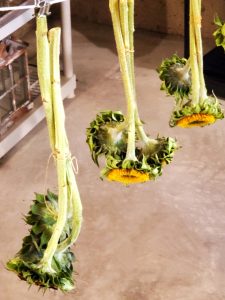
Drying The Flower Petals
To dry sunflower petals, carefully remove the yellow petals. After removing the outer ray petals, use two sheets of parchment paper or blotting paper and lay them in a single layer. I typically like to press our petals face-side down. Lay the petals face-side down and let them dry for two weeks. Next step, I placed a heavy marble pastry board on top to give the petals a flat surface and I let the petals dry for two weeks. Drying the petals can also be achieved using cardboard, blotting paper, or natural parchment paper. Stack cardboard, then paper, and cardboard on top of the petals. Add them to a heavy book and check them in two weeks. The sunflower petals should have a dry papery touch, if not add them to the book and dry the flower petals longer. To keep the vibrant colors of the petals, spray lightly with unscented hairspray.Supplies List:
- *Fresh flowers
- *Silica Gel
- *Airtight plastic container
- *Garden Pruners or scissors
- *Gloves and mask (recommended)
- *Paper towels
Preparing Petals and Heads for Silica Gel
Placing Sunflower Heads: A Delicate Touch
Silica is non-toxic, however, it’s advised to wear a mask and gloves for extra safety. Silica particles may irritate the throat and your skin so safety is important. To dry the head of the sunflower in silica gel, cut it leaving two inches of stem, and it should face up in an airtight container. Add the gel over the head until completely covered, and allow the petals and the head to dry for 2-7 days. Store the airtight container in a cool, dry location. If the container is deep enough, you can preserve two layers of the heads at a time.
Drying Flower Petals
If you’re using silica gel to dry the flower petals of a sunflower, you want a 1-inch layer of silica on the bottom of your airtight container. Layer the petals in a single layer in your airtight container and sprinkle the silica covering the flower petals completely. The silica gel drying process should take 2-7 days. Put the airtight container in a cool, dry place. Be sure the moisture is removed from the yellow petals and the seed head, or you may wind up with a moldy flower head. Wear a mask and gloves for extra safety. Silica particles may irritate the throat and your skin.Microwave: Quick and Controlled Drying
The microwave drying process for sunflower petals and the head of the flower is quick and requires heat many times. It’s advisable to wear gloves and a mask. Silica is non-toxic but can irritate the throat and skin. For safety reasons, it’s best to wear gloves and a mask. Cut the sunflowers with two inches of stem. Using a microwave-safe container, add 1 inch of gel. Add the head or petals and cover the flowers, with gel. Set the microwave on high power for 20-40-second intervals. By adhering to these detailed steps, you’ll ensure the successful preservation of your sunflowers. Wearing gloves, carefully remove each head of the sunflower and petals and wipe off any remaining gel. Spray the dried sunflower heads, sunflowers, or flower petals with unscented hairspray to keep their bright colors. Enjoy! Be sure to check my decorating ideas and tips. Many work for fall, Christmas, and through the winter months! Don’t forget to check how we can help the local wildlife when food is scarce during the winter too!CLICK ON THE PHOTO AND DIRECTLY SHOP!
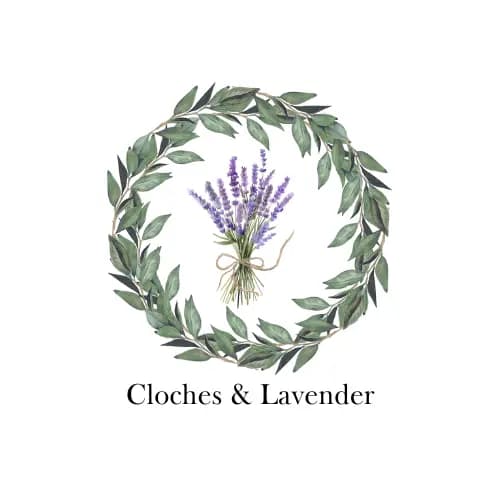
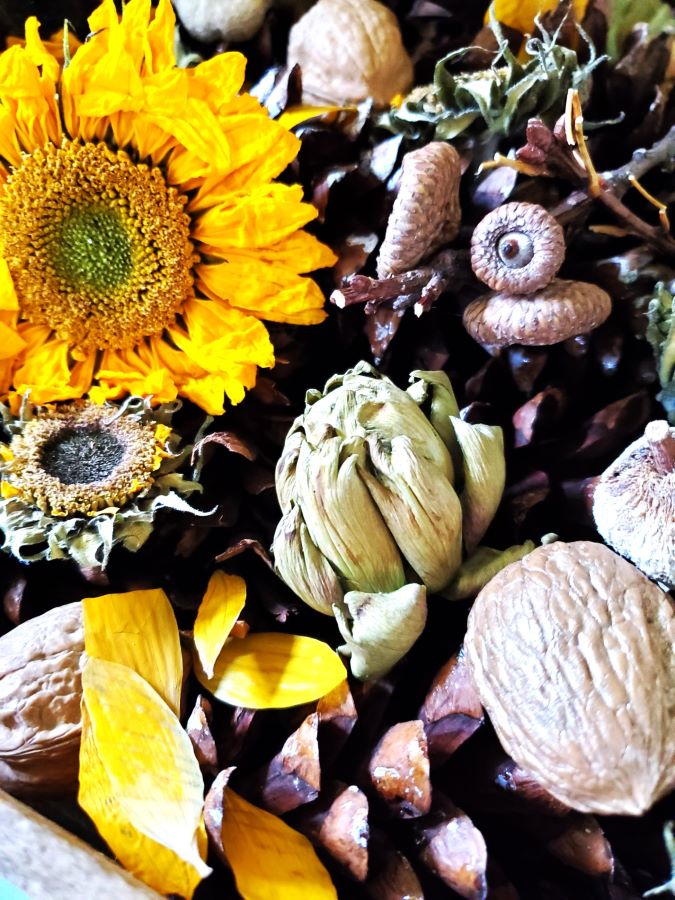

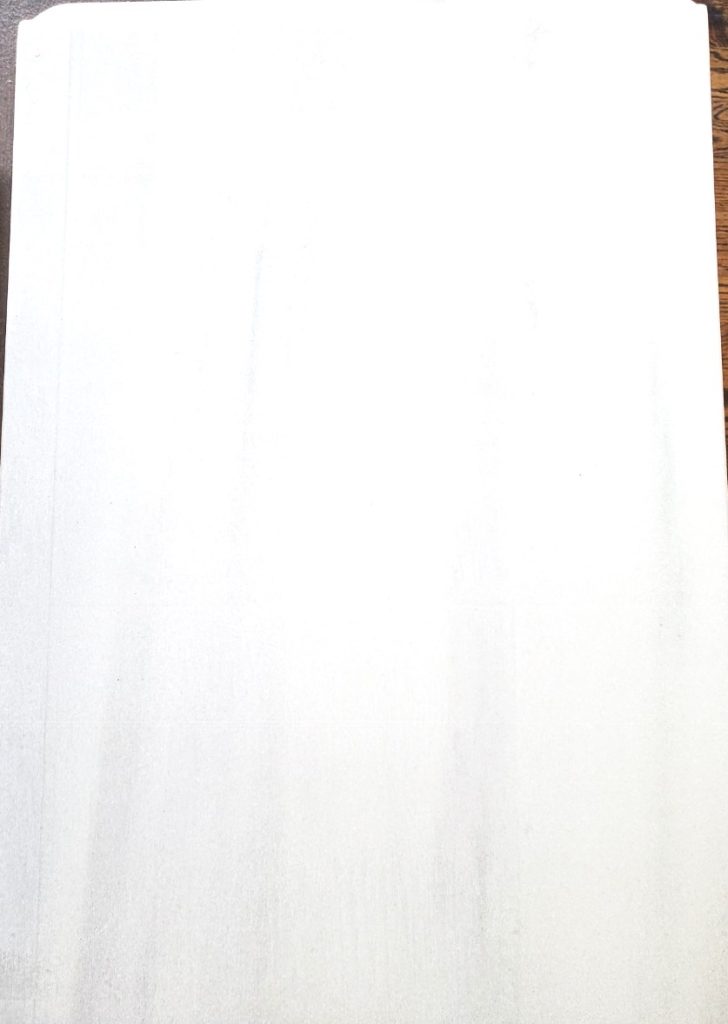

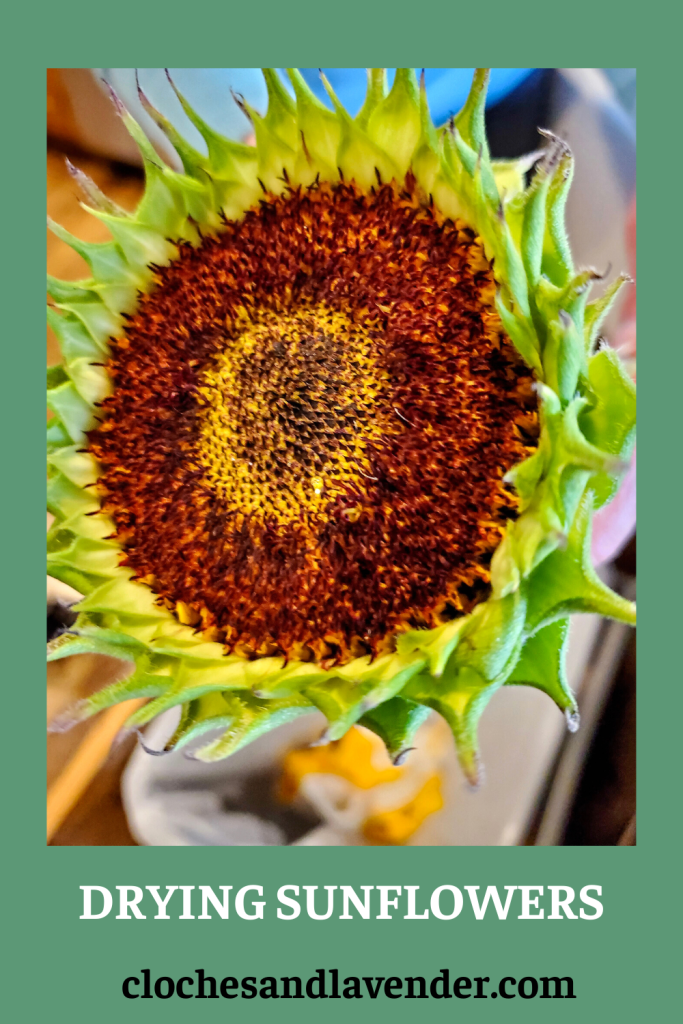
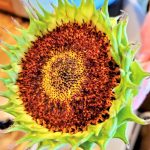
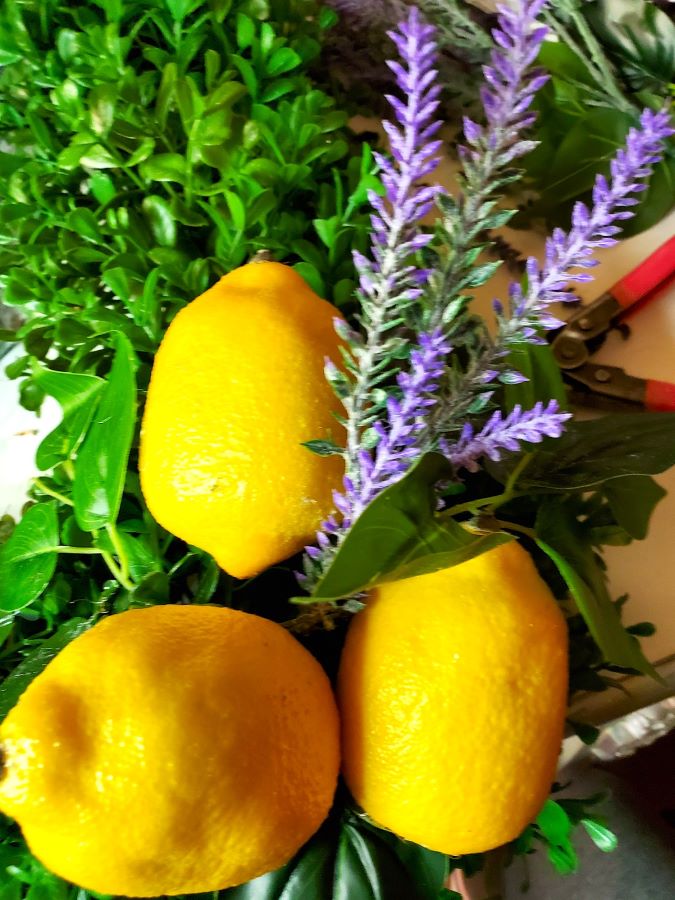

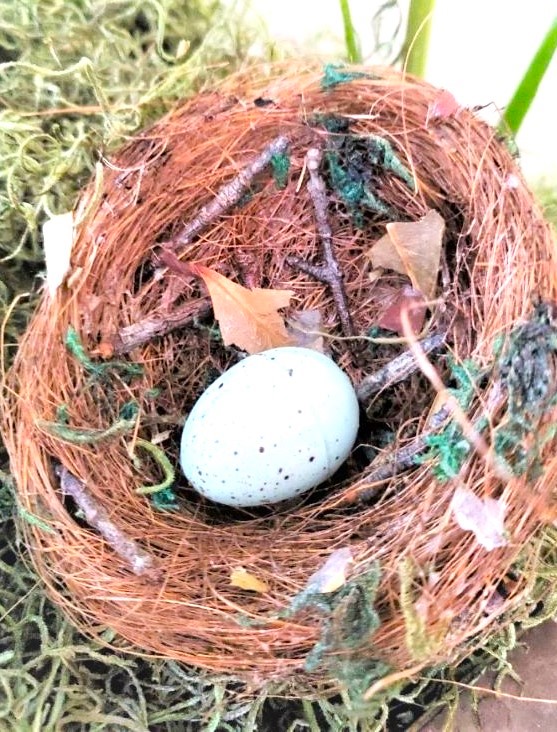
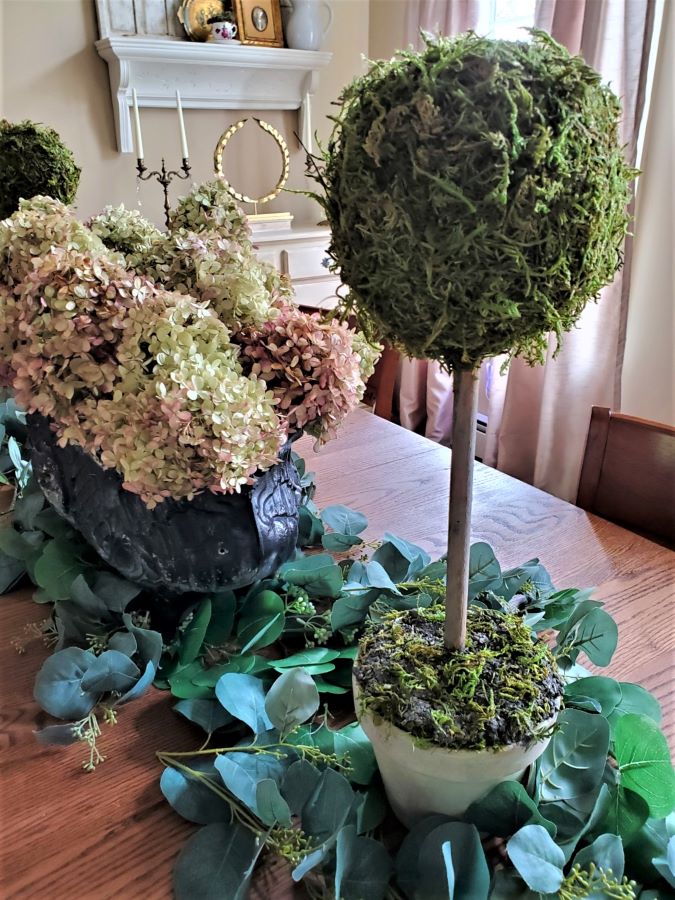
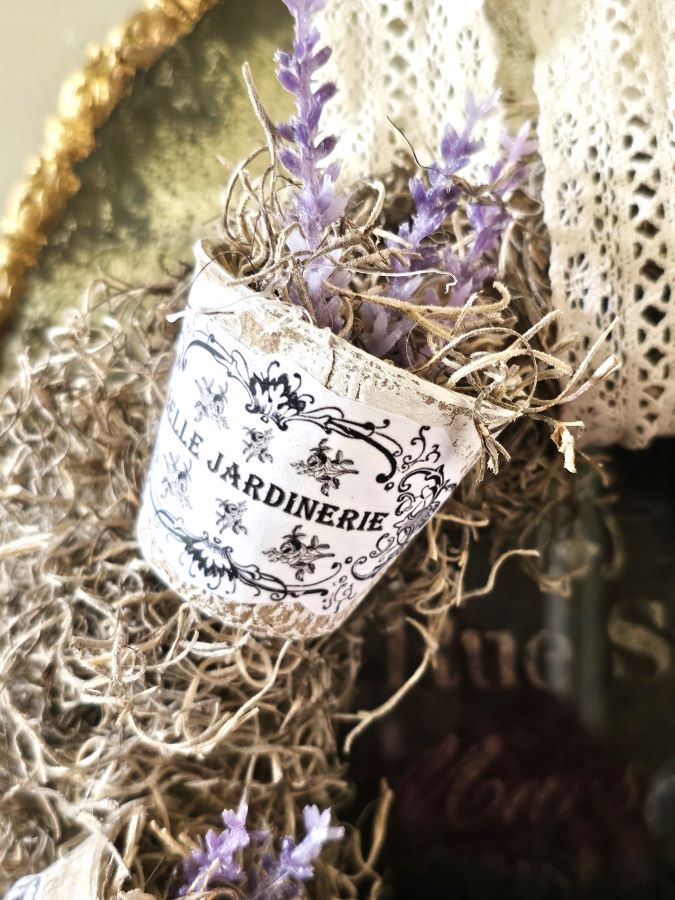
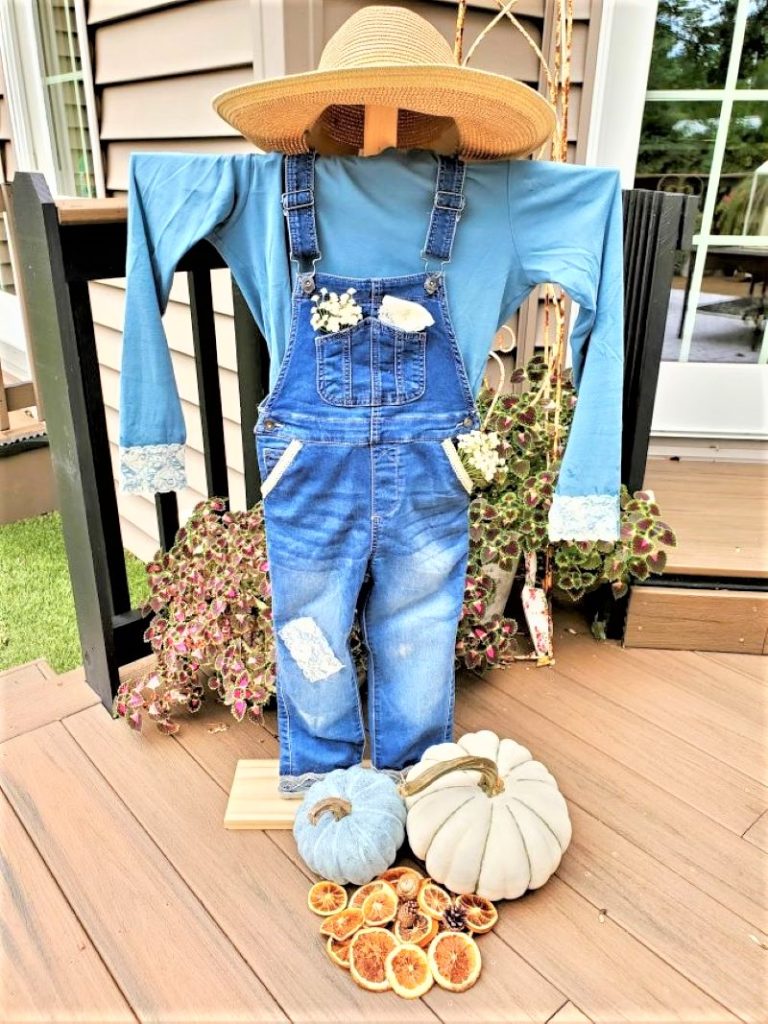
This is great information Cindy on how to dry sunflowers. I had heard that using hairspray when drying almost any flowers will keep the color and keep them open and pretty while they dry out. Yours turned out so great. Have a great week. xoxo Kris
I have never done this. They sure look great in all the photos you shared today. Happy Fall to you and your family Cindy!
Thanks so much my friend
Very cool!! I actually have a few sunflowers in my garden. Late bloomer…I might try this out!! Thanks!!
Do it! So easy
Get drying girlfriend
I had no idea, you could dry sunflowers out like this Cindy, that is so cool! I love the different ways you can display them too. They’re perfect for this time of year and make the transition into the Fall season such a pretty one. Hugs, CoCo
Thank you so much sweet CoCo
This is amazing! I love this so much! Now I want to grow them, so I can do this!
Buy them at the food store. They’re inexpensive. That’s what I did
I can’t grow them because our new yard is smaller
Perfect idea for fall ! I also like your bin of corn. Thanks for sharing your drying method.
Thank you so much!
I’m regretting throwing a vase of Sunflowers into my compost pile rather than drying them like you did. You will enjoy using these for decorating for years to come.
I’m going to dry more next fall. I have an idea
Who knew you could dry sunflowers? Now I know! Beautiful!
Thanks Amy. I’m going to do more next year!
Thank you for this tutorial. I am excited to share it with my daughter that grew a HUGE sunflower this year.
Oh that will be fun!
Such a neat idea. Thank you for the tutorial!
What a great idea. I didn’t realize you could dry them and they look so good in displays. Thank you for sharing.
I love them. I’m going to dry more for next fall.
Love it thanks for sharing with us – I’ll be featuring you this week when the new To Grandma’s house we go party starts!
Thanks so much!
Thanks so much for featuring my sunflowers
I’m thinking I will pick some up at Trader Joe’s on my next trip and dry them. I love the look.
I hope you do!
Such a beautiful way to preserve Fall’s bounty, Cindy! These dried sunflowers are gorgeous and I love that you can use them in so many different ways too. I can’t wait to try your techniques! Hugs, CoCo
Thank you CoCo for your support as always
Your dried sunflowers are so pretty and perfect for this time of year! I want to try that silica bead technique sometime! Thanks for all the fabulous info! Take care, Donna
I had never thought to try drying sunflowers, and yet I have admired the dried sunflower heads I have seen for sale! After a visit to a sunflower farm, I may have to try this!
This is so brilliant! What a great idea to get them to last much longer. I love the look of them.
satrialiga “Play in the best Satrial Liga games around the world
satrialiga “Play in the best Satrial Liga games around the world
win lots of prizes on this site, let’s join and play hereTerataibola“